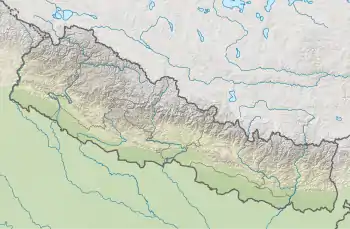Jagdishpur Reservoir
The Jagdishpur Reservoir is a reservoir in Jahadi Village Development Committee, Kapilvastu District, Nepal which was named after Er. Jagadish Jha who designed and supervised the construction of Banaganga dam. With a surface area of 225 ha (2.25 km2),[2] it is the largest reservoir in the country and an important wetland site.[3] It is situated at an altitude of 197 m (646 ft).[4] The maximum water depth varies between 2 m (6.6 ft) in the dry season and 7 m (23 ft) in the monsoon season.[5]
| Jagdishpur Reservoir | |
|---|---|
.JPG.webp) A group of sarus cranes (Antigone antigone) at Jagdishpur Reservoir | |
 Jagdishpur Reservoir | |
| Location | Jahadi, Kapilvastu District, Nepal |
| Coordinates | 27°35′00″N 83°05′00″E |
| Lake type | Reservoir |
| Primary inflows | Banganga River |
| River sources | Banganga River |
| Primary outflows | Banganga River |
| Catchment area | Sivalik Hills |
| Basin countries | Nepal |
| Managing agency | Department of Irrigation and District Forest Office |
| Designation | Ramsar List of Wetlands of International Importance |
| Max. length | 1.6 km (1 mi) |
| Max. width | 1.4 km (1 mi) |
| Surface area | 225 ha (556 acres) |
| Surface elevation | 197 m (646 ft) |
| Settlements | Dhankauli, Hathausa, Jahadi, Jayanagar, Kapilvastu, Kopawa, Nigalihawa |
| Designated | 13 August 2003 |
| Reference no. | 1315[1] |
The Jagdishpur Reservoir is listed on the List of Ramsar Wetlands of International Importance, as defined by the Ramsar Convention.[6]
History
At Jakhira Lake during the 1970s, Jagdishpur was created to provide water to crops.[4] In 2003, the reservoir was declared a Ramsar site.[6] Despite this, its birds and other fauna have not yet been studied in great detail.[5]
Fauna
The silt and nutrients deposited in the reservoir favour the growth of reed beds, which provide shelter for several endangered species. The habitat of the reservoir and its surroundings is important for resident, wintering and migrating wetland birds, comprising 45 different bird species.[4] Five of these are globally threatened species.[7] The surrounding cultivated land also provides habitat for a large numbers of birds. Some of the notable species documented in the area include:[5]
- Asian openbill (Anastomus oscitans)
- Black-winged kite (Elanus caeruleus)
- Egyptian vulture (Neophron percnopterus), a globally threatened species
- Greater spotted eagle (Clanga clanga), a globally threatened species
- Indian spotted eagle (Clanga hastata), a globally threatened species
- Lesser adjutant (Leptoptilos javanicus), a globally threatened species
- Long-tailed shrike (Lanius schach tricolor)
- Oriental darter (Anhinga melanogaster)
- Pied kingfisher (Ceryle rudis)
- Red-wattled lapwing (Vanellus indicus)
- Ruddy kingfisher (Halcyon coromanda)
- Sarus crane (Grus antigone), a globally threatened species
- Slender-billed vulture (Gyps tenuirostris), a globally threatened species
- Smooth-coated otter (Lutrogale perspicillata), a globally threatened species
- White-rumped vulture (Gyps bengalensis), a globally threatened species
- Woolly-necked stork (Ciconia episcopus), a globally threatened species
Also 18 species of fish, nine of herpetofauna and six mammalian species have been documented in and around the reservoir.[4]
References
- "Jagadishpur Reservoir". Ramsar Sites Information Service. Retrieved 25 April 2018.
- "Jagadishpur Reservoir". Protected Planet. Retrieved 5 January 2022.
- Bhandari, B. (1996). An inventory of Nepal's Terai wetlands. IUCN Nepal, Kathmandu.
- Bhuju, U. R.; Shakya, P. R.; Basnet, T. B.; Shrestha, S. (2007). Nepal Biodiversity Resource Book. Protected Areas, Ramsar Sites, and World Heritage Sites (PDF). Kathmandu: International Centre for Integrated Mountain Development, Ministry of Environment, Science and Technology, in cooperation with United Nations Environment Programme, Regional Office for Asia and the Pacific. ISBN 978-92-9115-033-5. Archived from the original (PDF) on 2011-07-26. Retrieved 2018-12-14.
- Baral, H. S. (2008). "Birds of Jagdishpur Reservoir, Nepal" (PDF). Forktail. 24: 115–119. ISSN 0950-1746.
- Bhandari, B. B. (2009). Wise use of Wetlands in Nepal. Banko Janakari 19 (3): 10–17.
- Baral, H. S.; Inskipp, C. (2005). Important Bird Areas in Nepal: key sites for conservation (1st ed.). Kathmandu, Nepal and Cambridge, UK: Bird Conservation Nepal and BirdLife International. ISBN 978-99933-792-2-5.
Further reading
- Baral, H. S. and Chaudhary, B. (2003). A list of birds recorded at Jagdishpur Reservoir, May 2003. Unpublished report submitted to Bird Conservation Nepal
- BirdLife International (2008). Species Factsheets. Available at http://www.birdlife.org. Accessed on 8 June 2008.
- Choudhary, H. and Giri, D. (2006). A list of birds recorded in Lumbini, Jagdishpur Reservoir and Khadara Phanta, November 2006. Unpublished.
- DNPWC and IUCN (2003). Information sheet on Ramsar wetlands: Jagdishpur Reservoir. Unpublished report submitted to the Ramsar Convention Bureau.
- Giri, D. (2008). "Largest breeding colony of Asian Openbill Anastomus oscitans outside protected areas of Nepal". Danphe. 17 (1): 7.
- HMGN/MFSC (2003). National wetland policy 2003. Kathmandu: Ministry of Forest and Soil Conservation, His Majesty's Government of Nepal.
- Inskipp, C. and Inskipp, T. (1991). A guide to the birds of Nepal, Second edition. London: Christopher Helm.
- Inskipp, T., Lindsey, N. and Duckworth, W. (1996). An annotated checklist of the birds of the Oriental region. Sandy, U.K.: Oriental Bird Club.
- IUCN Nepal (2004). A review of the status and threats to wetlands in Nepal. Kathmandu: IUCN Nepal.